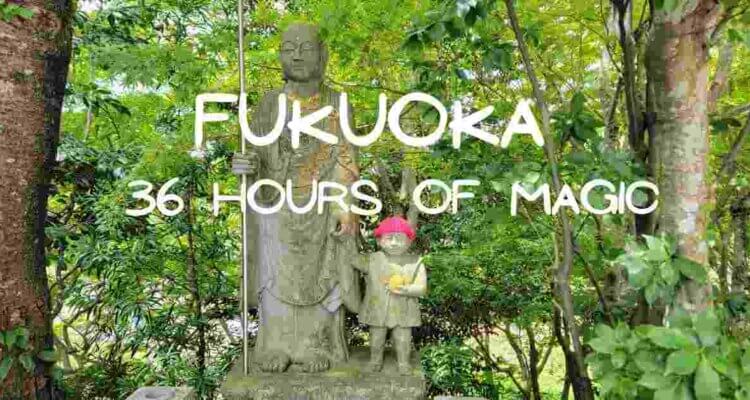On our Fukuoka layover we had to pack a ton of activities into our 36 hours in Fukuoka city. This is a vibrant city in Japan’s Kyushu region (the southern part) and is known for its laid back style, delicious food, stunning temples, canals, friendly people, and lively nightlife.
We were travelling from Mongolia and got a 36 hours in Fukuoka as a gift. This is a place in Japan that we had never visited before so we were super excited to maximize this Fukuoka stopver! What a gift?! We had fallen in love with Japan at the beginning of our travels and have visited many times. However, we had never been to the south. So we were incredibly excited about the opportunity and wanted to squeeze as much as possible into our full day here.
Read on to find out about our perfect 36 hours in Fukuoka – what we did and where we went on this Fukuoka quick trip.
Fukuoka Layover – 1 Day Itinerary
This itinerary is quite full. It has all the recommended things to do in Fukuoka layover. Our goal was to optimize our 36 hours in Fukuoka and see as much of the magic that this city and it’s surroundings have to offer!
So, here is the order that we would recommend to see everything. However, pick and choose as you like:
- Go for a run or a morning walk (maybe with a green tea or a coffee) in Ohori Park. Great place to people watch and get a feel of the city.
- Travel to Nanzoin Temple. This is a great place to spend an hour or so. Depending on where you are traveling from, it may take you between 30 minutes and 1 hour to get there.
- Travel to Dazaifu and enjoy the variety of shrines, museums, shopping and cafes there. Budget 2-3 hours here. Travel time will vary between 30 minutes – 1 hour.
- Return to the city for a late lunch at one of the Hakata Ramen restaurants mentioned below.
- Pass through the Canal City Hakata complex to catch one of the shows which runs every 30 minutes between 10:00 and 22:00.
- Finish off the evening by enjoying some of the delicious food at one of the Yatai Street Stalls or perhaps one of the vegan restaurants.
PRO TIPS:
- Many of the train/metro stations do not accept western credit cards. There are many ATMs to withdraw cash.
- There are subway/train workers who speak English and can help with ticket purchases which can be confusing.
- Use Googlemaps to time the trains. Some of them (including the Dazaifu) one only run every 30 minutes.
Nanzoin Temple: Home to the Giant Reclining Buddha
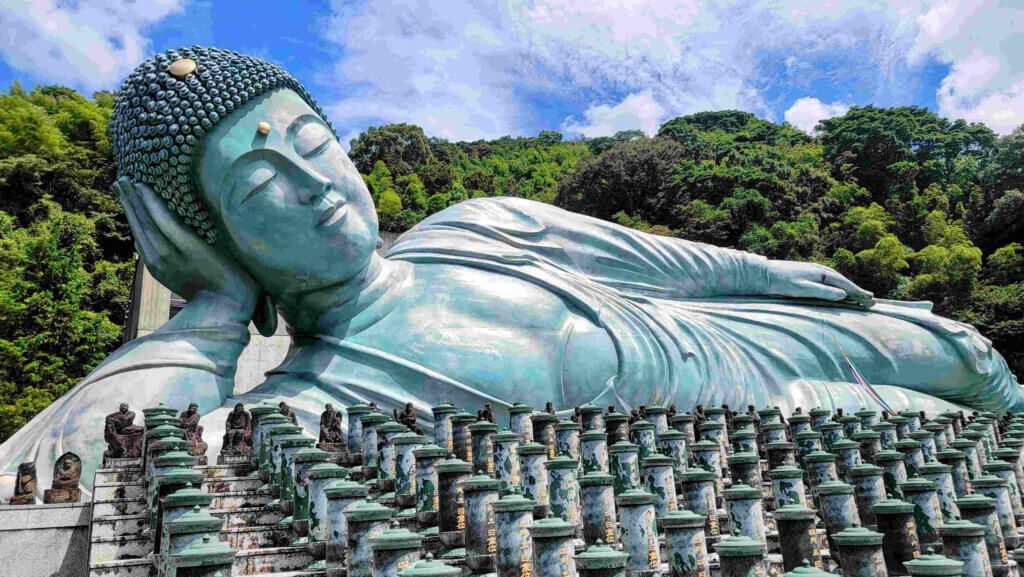
Nanzoin Temple is a must-visit for any Buddhist or art lover traveling to this area. The temple is located in the hills of Sasaguri, just 15 km from the city. Nanzoin Temple is home to a giant reclining Buddha statue, one of the largest in the world.
The statue is 41 meters long and 11 meters high and it is made of bronze. It was completed in 1995 and is said to represent the Buddha entering nirvana, or the state of perfect enlightenment. The statue is situated on a large terrace, so that visitors can walk around the front of it and admire the Buddha and it’s view.
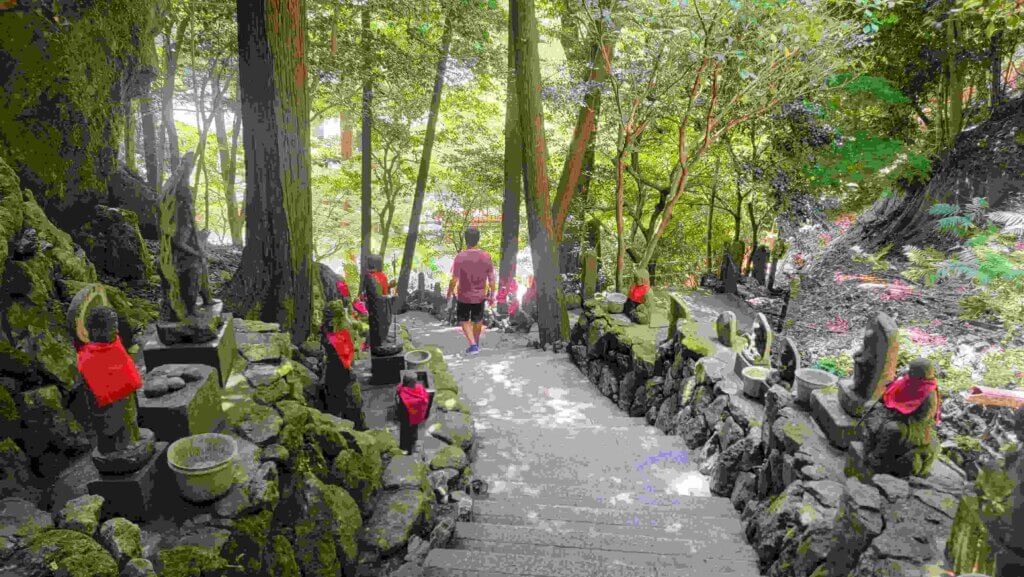
In addition to the reclining Buddha, Nanzoin Temple also has a number of other interesting features. These include a number of smaller Buddha statues, a garden, and a museum. The museum houses a collection of Buddhist artifacts. There is a charge to visit the museum – the rest is free.
The temple is a popular day trip destination from Fukuoka, and it’s easy to get to by train. The nearest station is Kido Nanzoin-mae Station, which is a short walk from the temple.
If you’re looking for a peaceful and spiritual place to visit in Japan, Nanzoin Temple is the perfect spot. The giant reclining Buddha is a truly awe-inspiring sight, and the other features of the temple are sure to leave you impressed.
Although one can spend quite a bit of time here, an hour or hour and a half would suffice.
Dazaifu Tenmangu Shrine
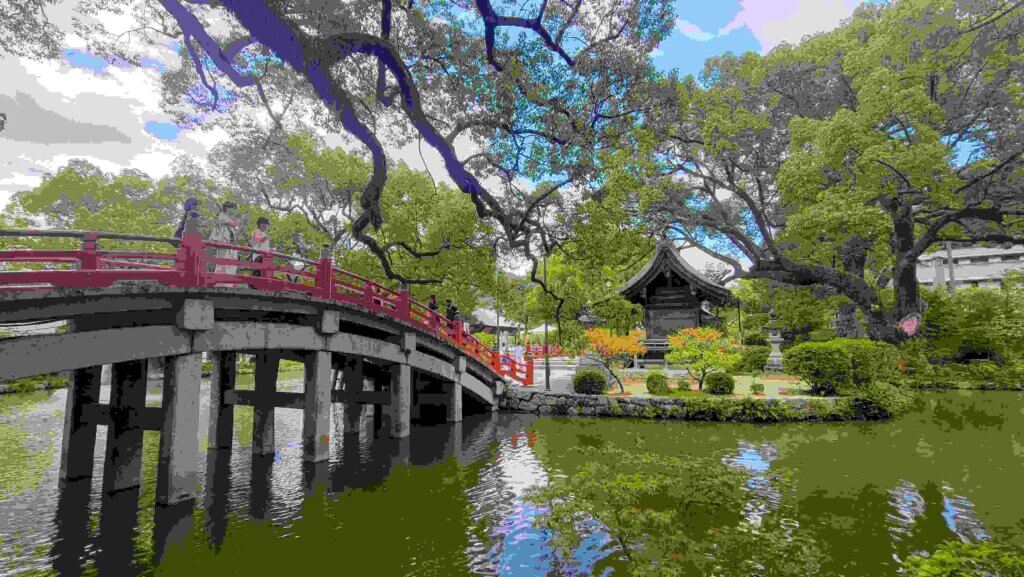
Out of the hundreds of Tenmangu shrines in Japan, the Dazaifu Tenmangu Shrine is one of the most famous ones. It is dedicated to Sugawara no Michizane, a famous scholar and poet who was deified as the god of learning and success.
The shrine complex is set in a park like setting with many buildings, additional shrines set on hill tops, a small lake, pretty bridges, a museum, and a library.
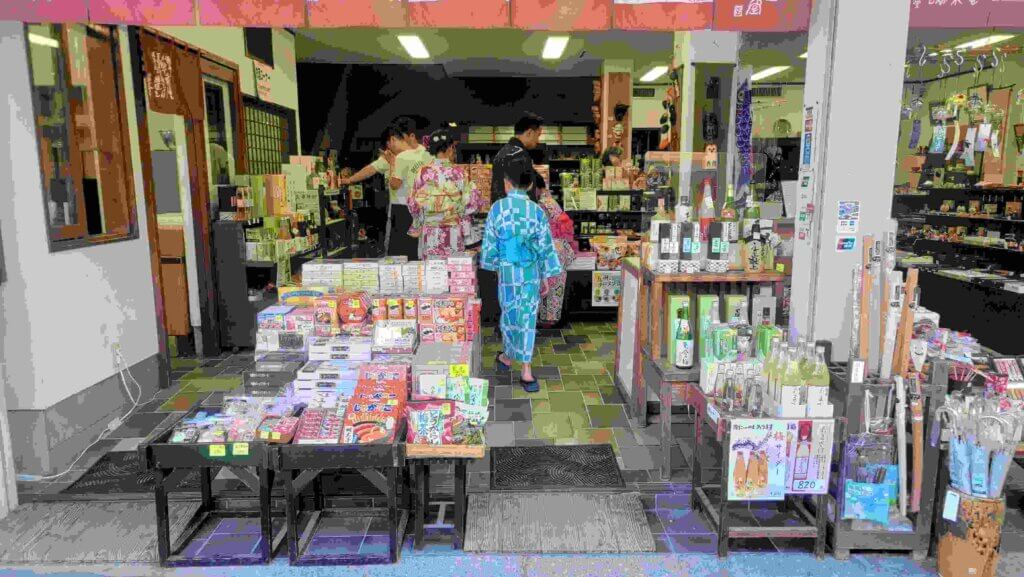
Unfortunately, the main hall is currently under renovation until approximately 2026. It is the most important building in the complex, and it’s where the enshrined deity, Sugawara no Michizane, is typically worshiped. However, a unique temporary offering hall with grass and trees on its roof was built to serve visitors during the renovation period.
We enjoyed the train ride from the city (about 23 minutes) as well as the whole Dazaifu area. Arriving on the train from the main city, we felt like we were in mini Kyoto with many restaurants, handicraft shops, cafe’s, etc., lining the main walking street. There is something here for everyone!
We spent about 2.5 hours here as we hiked all around the Dazaifu area visiting the hill top shrines. In addition, the handicraft shops were unique and we purchased a couple of handmade scarves to bring back to family.
Ohori Park
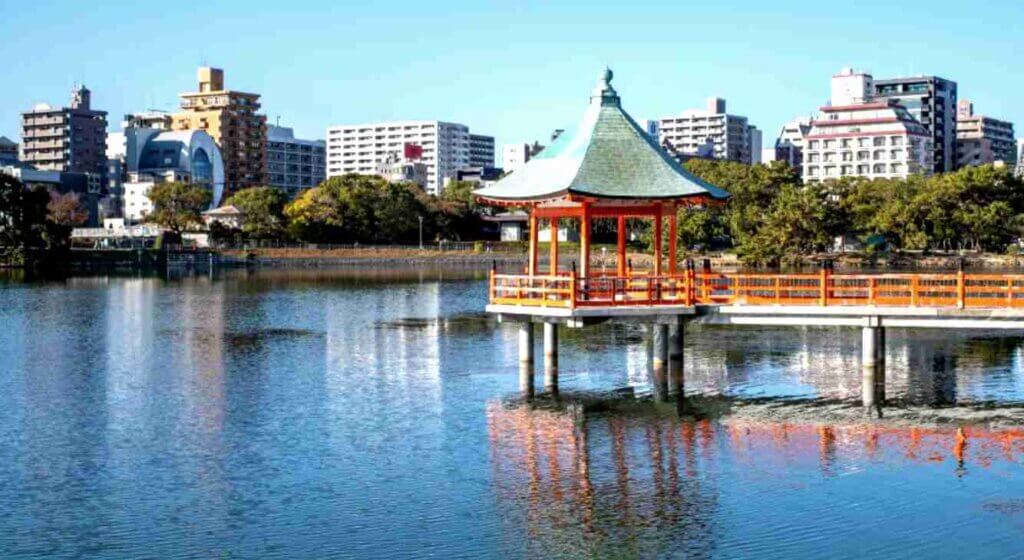
Ohori Park is located in the heart of the city. It is a beautiful and peaceful oasis away from the hustle and bustle of the city.
The park is home to a large pond, several gardens, and a variety of trees and flowers. There are also a number of bridges and pagodas scattered throughout the park, adding to its beauty. There is a popular walking and jogging track which runs around the circumference of the pond which is a little bit over 2 km long.
One of the most popular features of Ohori Park are the Swan Boats. These boats are a great way to explore the pond and get a closer look at the fish and turtles that live there.
Another popular spot in the park is the Ohori Garden. This garden is home to a variety of flowers, including cherry blossoms, hydrangeas, and lotus flowers. The garden is especially beautiful in the spring and summer when the flowers are in bloom.
If you still have time, within the park is the Fukuoka Art Museum which contains an interesting collection of art and sculptures. This includes works by Dali and Miro. Opposite the museum is a small pay-to-enter Japanese garden, which contains tea houses, a stone garden and a small pond.
One can spend as little as an hour in this park or as long as many hours – it is up to you. This is a wonderful place for an early morning run to start a perfect day.
Canal City Shopping
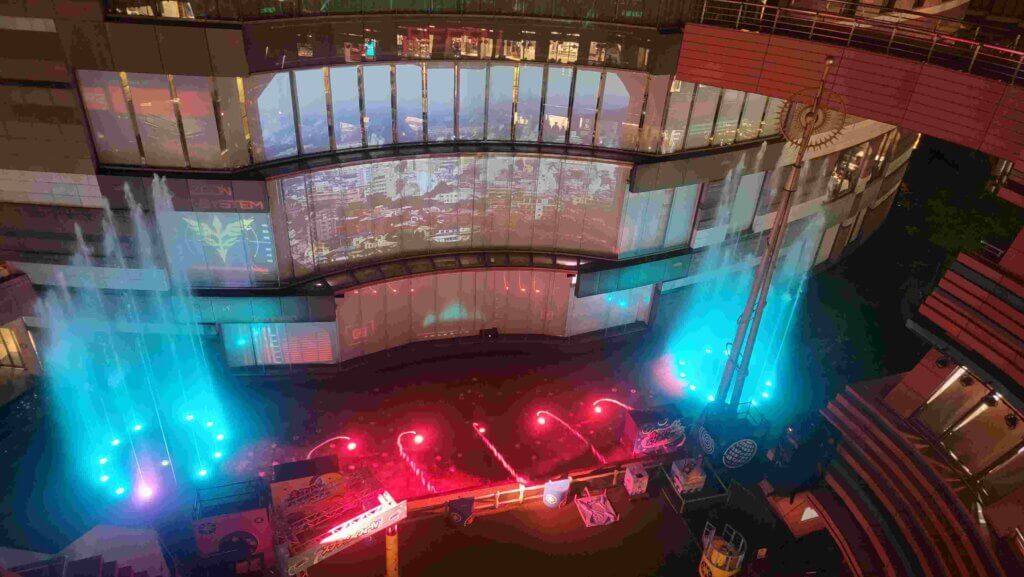
Canal City Hakata calls itself a city within a city. It has a canal that runs through it. At the center of the canal is a fountain with many spouts that has water shows every 30 minutes from 10:00 (am) until 22:00.
There are movie theaters, cafes, restaurants and shops here. The stores are mostly western with some interesting handicraft ones mixed in. There is even a very large Muji store here. A real Muji in the mother land?! So fun! For a one day itinerary, we do not recommend this as a specific destination, just a fun pass through on the way to perhaps taste the infamous food at some of the Yatai Street Stalls (which are close by).
Fukuoka’s Yatai Street Stalls

Fukuoka is renowned for it’s food. People from Tokyo, Osaka, Kyoto and other larger cities of Japan travel as often as they can to this city for it’s incredible foodie culture and delectable offerings.
This is a city that loves to eat, and nowhere is this more evident than at the yatai. These mobile food stalls are a way of life for many locals, and they offer a unique and authentic dining experience that is unlike anything else in Japan.
Yatai are typically located in the Nakasu, Tenjin, and Nagahama areas of Fukuoka, and they are open from late afternoon until late at night – typically 6 pm – 2 am. They are small and intimate, with only a few tables and chairs, so it is common to share a table with other diners.
The menu at a yatai typically features a variety of Japanese dishes, such as ramen, gyoza, okonomiyaki, and yakitori. The food is cooked fresh to order, and the prices are very reasonable.
In addition to the food, yatai are also known for their lively atmosphere. The stalls are often crowded and noisy, but this is all part of the experience. It is a great place to meet people and enjoy the laid-back atmosphere of Fukuoka.
If you are looking for a unique and authentic dining experience in Fukuoka, be sure to check out a yatai. It is a great way to experience the city’s vibrant food culture and meet some of the locals.
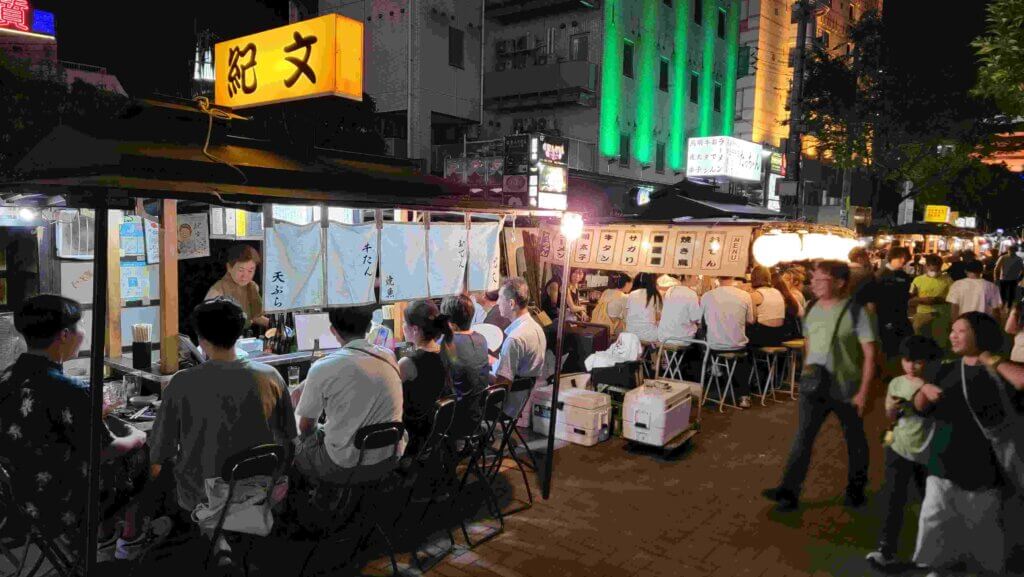
PRO TIPS:
- Go early. The best yatai tend to get crowded, so it is best to go early to avoid the lines.
- Be prepared to share a table. Yatai are small, so it is common to share a table with other diners.
- Order a variety of dishes. The menu at a yatai typically features a variety of dishes, so be sure to order a few different things to try.
- Do not overstay your welcome. These stall owners expect a high turnover, so once you are done eating – it is time to leave.
Hakata Ramen – Fukuoka’s Specialty
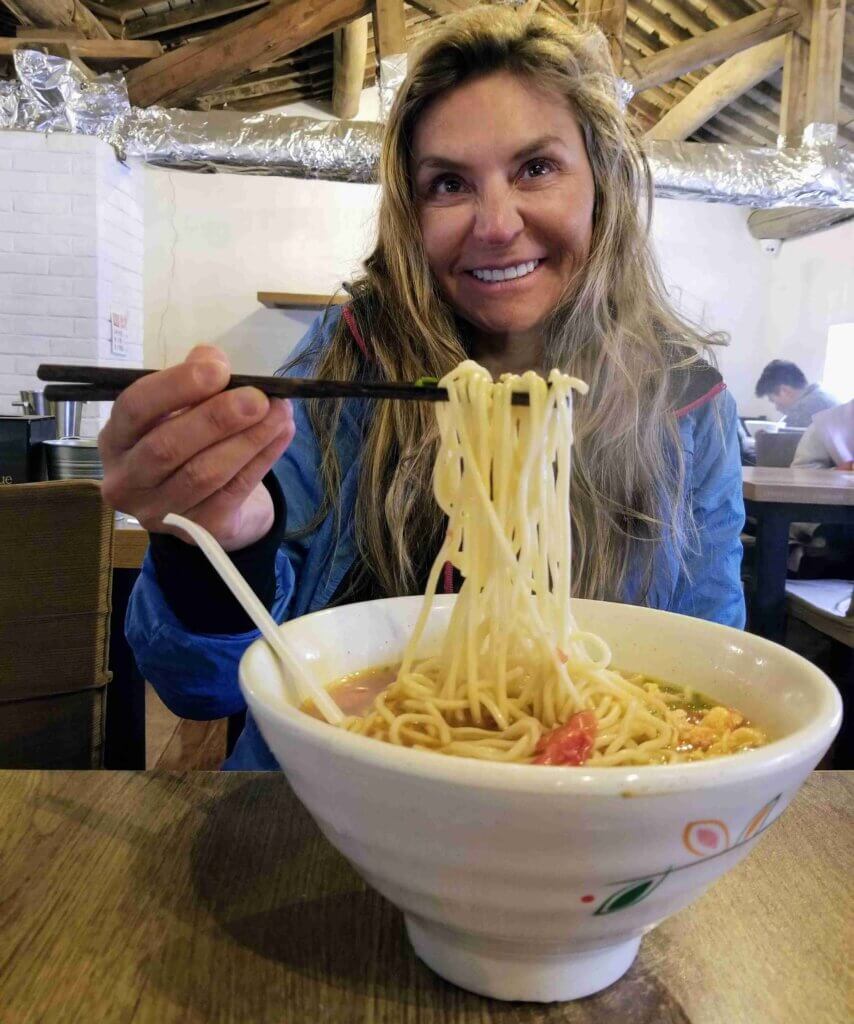
When it comes to food, this is a city that knows what it’s doing. And no dish is more popular than Hakata ramen, a type of tonkotsu ramen made with a thick, pork-based broth and thin, curly noodles.
Hakata ramen is said to have originated in the city’s Hakata district. The dish is made with a pork bone broth that is simmered for hours, until it becomes rich and flavorful. The noodles are thin and curly, and they are perfectly cooked to be soft and chewy.
Hakata ramen is typically topped with pork chashu, menma (bamboo shoots), and green onions. It can also be topped with other ingredients, such as ajitama (soft-boiled egg), narutomaki (fish cake), or kikurage (dried mushrooms).
If you’re looking for the best Hakata ramen in Fukuoka, there are a few places you should check out. Ichiran is a popular chain restaurant that is known for its customizable ramen. You can choose the richness of the broth, the firmness of the noodles, and the toppings you want.
Shin Shin Hakata Remen is another very popular restaurant in the city that serves well rated Ramen. Be prepared for a wait though, as this restaurant is very popular.
And if you are vegan like me and want to try some of the best vegan Ramen, then head over to Marutan. They serve some of the best vegan Ramen and other non vegan dishes.
Fukuoka Layover – Where to Stay
There are 763 hotels in this city! Therefore a lot to choose from on a Fukuoka stopover. However, one must think about location and proximity to the train/metro stations first and foremost. Especially when traveling here for only 2 nights, like us.
We stayed at the #1 hotel in the city (according to Tripadvisor) on IHG points. The hotel is ANA Crowne Plaza. It was OK, however we would only rate it an 8 out of 10 at best. Especially due to the rude staff.
Therefore, check some other options. There are quite a few options in booking.com as well as Airbnb.
Wrap Up – Fukuoka Layover

A Fukuoka quick trip was such a delight as this is a super laid back city with so many things to see and do. In addition, this is the foodie lovers destination of choice for so many Japanese citizens and visitors alike! Residents of other large cities of Japan, make this city a weekend food destination at least a few times a year. So, a Fukuoka stopover is kind of a thing here!
For us, the nearby destinations of Nanzoin Temple and the Dazaifu Tenmangu Shrine were the real highlights of this packed yet magical day.
Have you been to this area or perhaps some of the other Buddhist countries like Myanmar, or Bhutan? What was your favorite part? We would love to hear from you in the comments!

